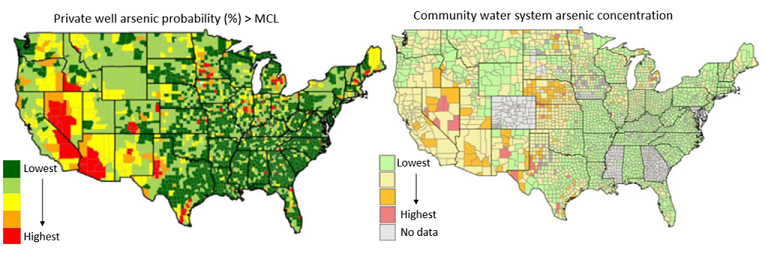Superfund Research Program
Characterizing Arsenic Exposure in Public Water Supplies and Private Wells
View Research Brief as PDF(349KB)
Release Date: 08/04/2021
![]() subscribe/listen via iTunes, download(7.5MB), Transcript(90KB)
subscribe/listen via iTunes, download(7.5MB), Transcript(90KB)
A recent NIEHS Superfund Research Program (SRP)-funded study revealed that while arsenic concentrations in community water systems (CWS) have decreased over time, certain populations are still vulnerable to elevated levels of arsenic.
Arsenic occurs naturally in the earth’s crust, where it can contaminate groundwater at levels unsafe for human consumption. Groundwater is a major source for many CWS and private wells in the U.S. The U.S. Environmental Protection Agency (EPA) established a maximum contaminant level (MCL) for arsenic of 10 micrograms per liter for CWS. According to the authors, some CWS continue to exceed this level, particularly those reliant on groundwater and serving smaller populations.
The authors sought to explore how private well arsenic concentrations, which are not regulated by the MCL, are associated with CWS arsenic exposures. They explained that in areas with limited data for groundwater arsenic, understanding any relationships could help determine CWS arsenic data. This information would allow community members and regulators to predict where it would be beneficial to increase testing of private well water and establish strategies to prevent exposure.
They used a database of private well arsenic samples and statistical models developed by researchers at the United States Geological Survey (USGS) and additional institutions that estimate the probability of private wells exceeding the MCL at the county level. They also used estimates of arsenic in CWS at the county level from 2006 to 2011 previously developed by Anne Nigra, Ph.D., and other Columbia SRP Center researchers using the EPA National Contaminant Occurrence database.
Comparing Private and Public Drinking Water
Their analysis revealed that, on average in 2006-2011, there was an increase in the probability of private well arsenic exceeding the MCL. This was associated with increased arsenic concentrations in CWS at the county level across the U.S.
To see if this association was similar across different populations, they broke down their analysis by regions and sociodemographic clusters. They observed that CWS arsenic concentrations differed by region, and the association with private well arsenic levels was highest in counties that source most of their drinking water from groundwater supplies in the Central Midwest, Southwest, and the Pacific Northwest.
They also found that the strongest associations between private well arsenic and CWS arsenic concentrations occurred in rural counties with American Indian populations, and rural counties with mid- or low-socioeconomic status (SES).

Differences Over Time
The researchers compared CWS arsenic concentrations between 2006-2008 and 2009-2011, which are the first monitoring periods for compliance with the arsenic MCL.
Nationwide, the association between private wells and CWS decreased over time, potentially driven by the interventions to reduce arsenic in CWS to meet the MCL. However, this change varied regionally and by sociodemographic cluster.
The greatest decline in this association, from 2006-2008 to 2009-2011, was observed in the Southwest, a region known to have high concentrations of groundwater arsenic. In this region, private well arsenic remained unchanged, but CWS levels decreased. In the Midwest, however, no significant decline was observed. According to the authors, these findings suggest that interventions to implement the new MCL in CWS were more pronounced in some regions.
Rural counties with American Indian populations, and rural counties with mid- or low-SES experienced the greatest decline in the observed association in the second monitoring period. The authors attribute these findings to the impact of federal programs to fund public water system infrastructure in rural communities. In contrast, in semi-urban, Hispanic counties, private well arsenic and CWS arsenic levels remained similar, and an increased association in the second period was observed.
Based on these findings, the researchers concluded, even with the availability of improved water resources, that socioeconomic inequities and disparities in arsenic exposure persist. They recommend that future research and technical assistance are needed to protect the most vulnerable communities, such as rural, mid- or low-SES, American Indian, and semi-urban Hispanic counties, from elevated drinking water arsenic exposure.
The study was made possible by a K.C. Donnelly Externship Award given to Maya Spaur, a trainee at the Columbia University SRP Center who received funding to work with Melissa Lombard, Ph.D., and Joseph Ayotte at USGS. The study was led by Spaur under the mentorship of Columbia University SRP Center Director Ana Navas-Acien, M.D., Ph.D.
For More Information Contact:
Ana Navas-Acien
Columbia University
Mailman School of Public Health
722 West 168th Street, Rm 1105
New York, New York 10032
Phone: 212-342-4712
Email: an2737@columbia.edu
To learn more about this research, please refer to the following sources:
- Spaur M, Lombard M, Ayotte JD, Harvey DE, Bostick BC, Chillrud SN, Navas-Acien A, Nigra AE. 2021. Associations between private well water and community water supply arsenic concentrations in the conterminous United States. Sci Total Environ 787:147555. doi:10.1016/j.scitotenv.2021.147555 PMID:33991916 PMCID:PMC8192485
To receive monthly mailings of the Research Briefs, send your email address to srpinfo@niehs.nih.gov.


